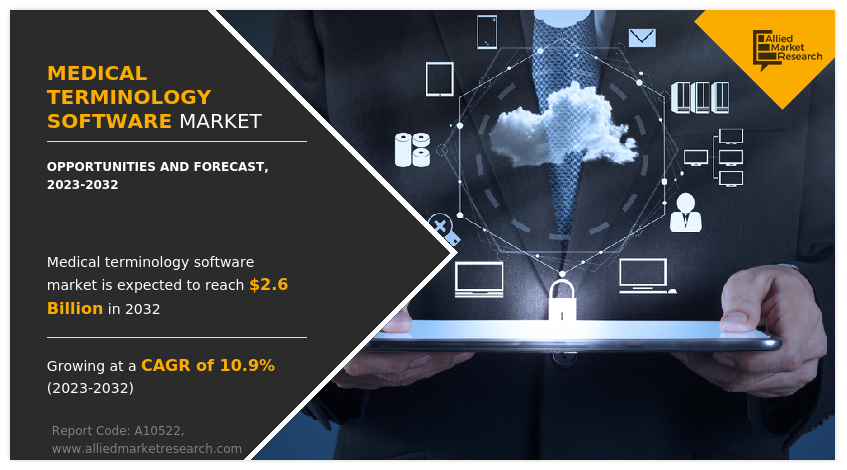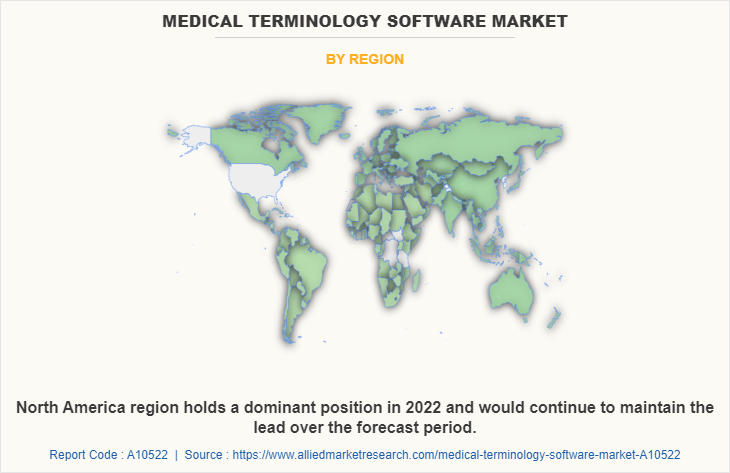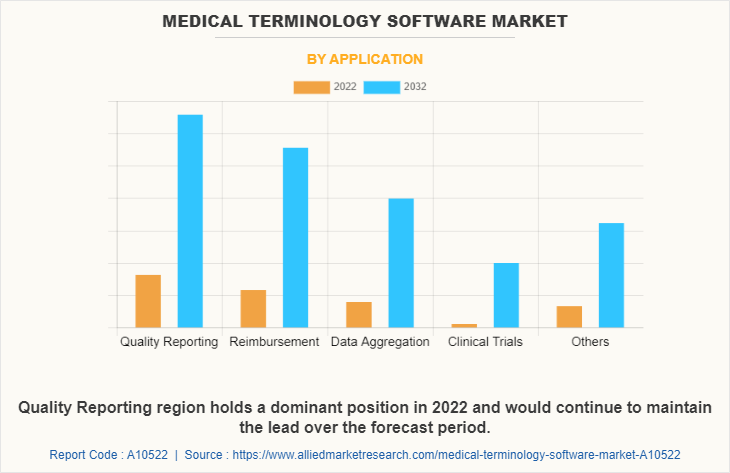
$2.6+Bn Medical Terminology Software Market to Grow at 10.9% CAGR, Globally, by 2032

In a recent report released by Allied Market Research, titled “Medical Terminology Software Market by Application and End User: Global Opportunity Analysis and Industry Forecast, 2023-2033,” insightful findings shed light on the robust trajectory of the global medical terminology software industry.
The comprehensive analysis reveals that in 2022, the industry boasted a substantial revenue of $0.9 billion, signaling a dynamic landscape within the healthcare technology sector. Projections indicate a notable surge, with the market poised to burgeon to an estimated $2.6 billion by the year 2032. This impressive growth trajectory is underpinned by a compound annual growth rate (CAGR) of 10.9% from 2023 to 2032.
Download Sample Copy- https://www.alliedmarketresearch.com/request-sample/10887
Prime determinants of growth
- Adoption of Electronic Health Records (EHRs): The widespread adoption of Electronic Health Records (EHRs) is a primary driver propelling the growth of the medical terminology software market. As healthcare providers transition towards digitized and integrated systems, the need for advanced software solutions to manage and interpret medical data becomes paramount. Medical terminology software seamlessly integrates with EHRs, facilitating efficient data management and enhancing overall healthcare service delivery.
- Prevalence of Noncommunicable Diseases (NCDs): The escalating prevalence of noncommunicable diseases (NCDs) globally contributes significantly to the demand for medical terminology software. The software’s ability to streamline data related to chronic conditions, facilitate accurate diagnosis, and support effective treatment planning positions it as an indispensable tool in the contemporary healthcare landscape.
- Focus on Quality Reporting and Regulatory Compliance: Healthcare providers worldwide are increasingly emphasizing quality reporting and regulatory compliance to meet stringent standards and enhance patient care. Medical terminology software plays a crucial role in ensuring accurate and standardized reporting, aiding healthcare institutions in adhering to regulatory requirements. This heightened focus on quality and compliance acts as a catalyst for the continued growth of the medical terminology software market.
- Data Privacy Concerns: Despite the positive growth indicators, data privacy concerns pose a potential restraint on market expansion. The sensitive nature of healthcare data necessitates robust security measures, and any perceived lapses in data privacy may impede the adoption of medical terminology software. Industry stakeholders must proactively address these concerns to build and maintain trust among users.
- Integration of Artificial Intelligence (AI): The integration of artificial intelligence (AI) into medical terminology software opens new vistas for innovation and efficiency. AI-driven functionalities enhance the software’s capabilities, enabling advanced data analysis, predictive modeling, and personalized healthcare insights. This integration presents lucrative opportunities for market players to develop cutting-edge solutions that further elevate the utility and sophistication of medical terminology software.
Procure Complete Report (243 Pages PDF with Insights, Charts, Tables, and Figures) https://www.alliedmarketresearch.com/checkout-final/medical-terminology-software-market

North America to maintain its dominance by 2031
The dominance of North America in the global medical terminology software market is set to endure, with projections indicating that the region will maintain its leading position through 2031. In 2022, North America asserted its prominence by capturing more than half of the market’s total revenue, a testament to its robust healthcare infrastructure and strategic adoption of Electronic Health Records (EHRs). Key factors contributing to North America’s sustained leadership include:
- Adoption of Electronic Health Records (EHRs): North America’s leading position is underpinned by the widespread adoption of EHRs by healthcare institutes. The seamless integration of medical terminology software with EHR systems enhances data management, supports clinical decision-making, and contributes to the overall efficiency of healthcare operations.
- Clinical Trials and Healthcare Infrastructure: The region’s dominance is further fueled by a high number of clinical trials and a surge in healthcare infrastructure development. North America’s commitment to advancing medical research and maintaining state-of-the-art healthcare facilities positions it at the forefront of the medical terminology software market.
- Upsurge in Healthcare Expenditure: A significant factor bolstering North America’s dominance is the substantial upswing in healthcare expenditure. This financial commitment enables the region to continually invest in cutting-edge technologies, including medical terminology software, thereby fortifying its leading position.
While North America is poised to continue its market dominance, the Asia-Pacific region emerges as a compelling growth frontier, projected to witness the fastest Compound Annual Growth Rate (CAGR) of 12.6% from 2023 to 2032. The driving forces behind the notable growth in the Asia-Pacific region include:
- Investments in Medical Terminology Software Development: The Asia-Pacific region is experiencing a surge in investments dedicated to the development of medical terminology software. This strategic focus on innovation positions the region as a key player in shaping the future landscape of the global market.
- Rise in the Number of Key Players: The presence of an increasing number of key players actively involved in the development of medical terminology software contributes to the region’s rapid growth. This competitive landscape fosters innovation, collaboration, and the introduction of advanced solutions.
As healthcare expenditure in emerging economies continues to rise, the medical terminology software market is presented with lucrative opportunities for expansion. While North America maintains its stronghold, the Asia-Pacific region’s robust growth signifies a shifting global landscape, emphasizing the dynamic and evolving nature of the medical terminology software market. Stakeholders in both regions are well-positioned to capitalize on these trends and contribute to the ongoing advancement of healthcare technology on a global scale.
Leading Market Players: –
- 3M Company
- BT Clinical Computing
- TermSolutions GmbH
- SNOMED International
- Clinical Architecture, LLC
- Intelligent Medical Objects Inc.
- Wolters Kluwer N.V.
- West Coast Informatics Inc.
- Hiveworx
- Rhapsody

𝐕𝐀𝐋𝐔𝐄 𝐏𝐑𝐎𝐏𝐎𝐒𝐈𝐓𝐈𝐎𝐍𝐒 𝐑𝐄𝐋𝐀𝐓𝐄𝐃 𝐓𝐎 𝐓𝐇𝐄 𝐑𝐄𝐏𝐎𝐑𝐓:
Powered with Complimentary Analyst Hours and Expert Interviews with Each Report
Comprehensive quantitative and qualitative insights at segment and sub-segment level
Covid 19 impact trends and perspective
Granular insights at global/regional/country level
Deep-rooted insights on market dynamics (drivers, restraints, opportunities) and business environment
Blanket coverage on competitive landscape
Winning imperatives
Exhaustive coverage on ‘Strategic Developments’ registered by leading players of the market
Editor Details
-
Company:
- The Wire Times
